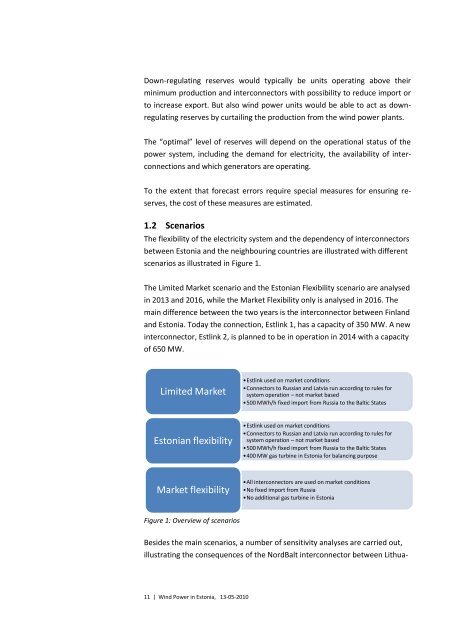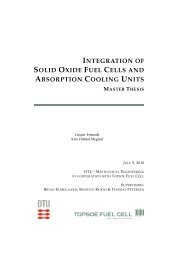Wind Power in Estonia - Elering
Wind Power in Estonia - Elering
Wind Power in Estonia - Elering
You also want an ePaper? Increase the reach of your titles
YUMPU automatically turns print PDFs into web optimized ePapers that Google loves.
Down-regulat<strong>in</strong>g reserves would typically be units operat<strong>in</strong>g above theirm<strong>in</strong>imum production and <strong>in</strong>terconnectors with possibility to reduce import orto <strong>in</strong>crease export. But also w<strong>in</strong>d power units would be able to act as downregulat<strong>in</strong>greserves by curtail<strong>in</strong>g the production from the w<strong>in</strong>d power plants.The “optimal” level of reserves will depend on the operational status of thepower system, <strong>in</strong>clud<strong>in</strong>g the demand for electricity, the availability of <strong>in</strong>terconnectionsand which generators are operat<strong>in</strong>g.To the extent that forecast errors require special measures for ensur<strong>in</strong>g reserves,the cost of these measures are estimated.1.2 ScenariosThe flexibility of the electricity system and the dependency of <strong>in</strong>terconnectorsbetween <strong>Estonia</strong> and the neighbour<strong>in</strong>g countries are illustrated with differentscenarios as illustrated <strong>in</strong> Figure 1.The Limited Market scenario and the <strong>Estonia</strong>n Flexibility scenario are analysed<strong>in</strong> 2013 and 2016, while the Market Flexibility only is analysed <strong>in</strong> 2016. Thema<strong>in</strong> difference between the two years is the <strong>in</strong>terconnector between F<strong>in</strong>landand <strong>Estonia</strong>. Today the connection, Estl<strong>in</strong>k 1, has a capacity of 350 MW. A new<strong>in</strong>terconnector, Estl<strong>in</strong>k 2, is planned to be <strong>in</strong> operation <strong>in</strong> 2014 with a capacityof 650 MW.Limited Market•Estl<strong>in</strong>k used on market conditions•Connectors to Russian and Latvia run accord<strong>in</strong>g to rules forsystem operation – not market based•500 MWh/h fixed import from Russia to the Baltic States<strong>Estonia</strong>n flexibility•Estl<strong>in</strong>k used on market conditions•Connectors to Russian and Latvia run accord<strong>in</strong>g to rules forsystem operation – not market based•500 MWh/h fixed import from Russia to the Baltic States•400 MW gas turb<strong>in</strong>e <strong>in</strong> <strong>Estonia</strong> for balanc<strong>in</strong>g purposeMarket flexibility•All <strong>in</strong>terconnectors are used on market conditions•No fixed import from Russia•No additional gas turb<strong>in</strong>e <strong>in</strong> <strong>Estonia</strong>Figure 1: Overview of scenariosBesides the ma<strong>in</strong> scenarios, a number of sensitivity analyses are carried out,illustrat<strong>in</strong>g the consequences of the NordBalt <strong>in</strong>terconnector between Lithua-11 | <strong>W<strong>in</strong>d</strong> <strong>Power</strong> <strong>in</strong> <strong>Estonia</strong>, 13-05-2010
















